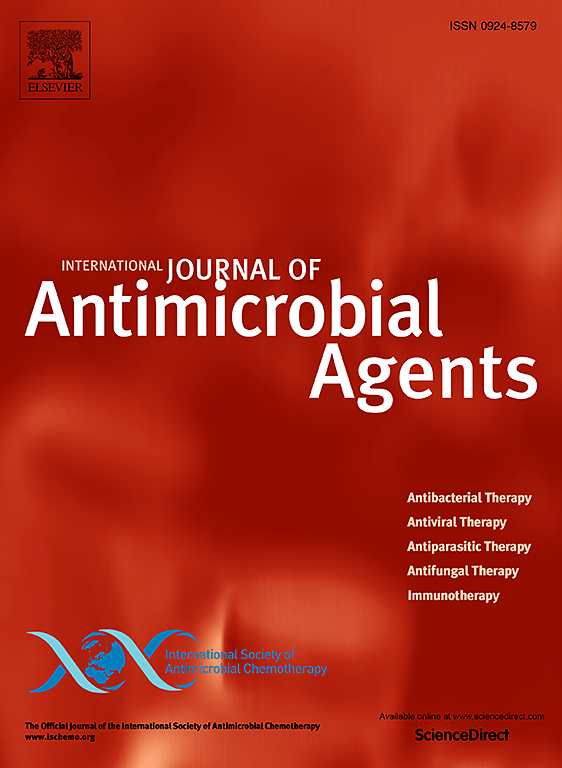Pharmacodynamic interaction of apotransferrin and anti-pseudomonal antibiotics against extensively drug-resistant Pseudomonas aeruginosa in a dynamic PK/PD model
IF 4.9
2区 医学
Q1 INFECTIOUS DISEASES
International Journal of Antimicrobial Agents
Pub Date : 2025-02-28
DOI:10.1016/j.ijantimicag.2025.107477
引用次数: 0
Abstract
Objectives: The rise of antibiotic resistance in clinical settings poses a major challenge. Apotransferrin has emerged as a potential non-traditional therapy for combating infections, potentially preventing resistance development while enhancing bactericidal effects. This study evaluated the efficacy of apotransferrin combined with antipseudomonal antibiotics against extensively drug-resistant (XDR) Pseudomonas aeruginosa isolates.
Methods: Twenty XDR P. aeruginosa clinical isolates were evaluated. Different apotransferrin concentrations were tested to determine the optimal in vitro concentration. Time-kill assays assessed the combined effects of apotransferrin with meropenem or ceftolozane/tazobactam (C/T). A chemostat model using four selected isolates validated the most effective combinations and monitored resistance emergence.
Results: Apotransferrin monotherapy did not reduce bacterial load, but its combination with antipseudomonal antibiotics enhanced efficacy. Meropenem activity improved in 10/20 isolates, and C/T activity in 13/20 compared to antibiotic monotherapy. The chemostat model confirmed synergistic interactions between apotransferrin and C/T in two isolates, with additive effects in two others. This combination outperformed the most effective monotherapy in all isolates, with no emergence of new C/T-resistant strains.
Conclusions: In conclusion, the combination of apotransferrin with C/T demonstrated superior in vitro efficacy against XDR P. aeruginosa isolates compared to either treatment alone. These findings suggest that apotransferrin could be a valuable adjunctive therapy, enhancing the antimicrobial effects of existing antibiotics and potentially extending their clinical utility.

载铁蛋白与抗假单胞菌抗生素对广泛耐药铜绿假单胞菌的药效学相互作用
临床环境中抗生素耐药性的上升构成了一个重大挑战。载铁转铁蛋白已成为一种潜在的非传统治疗方法,用于对抗感染,潜在地防止耐药性的发展,同时增强杀菌效果。本研究评价了转铁蛋白联合抗假单胞菌抗生素治疗广泛耐药铜绿假单胞菌的疗效。对20株XDR铜绿假单胞菌临床分离株进行了评价。通过对不同转铁蛋白浓度的测定,确定最佳体外浓度。时间杀伤试验评估转铁蛋白与美罗培南或头孢唑烷/他唑巴坦(C/T)联合使用的效果。采用四种选定菌株的趋化模型验证了最有效的组合,并监测了耐药性的出现。转铁蛋白单药治疗不能降低细菌负荷,但联合抗假单胞菌抗生素可提高疗效。与抗生素单药治疗相比,10/20株美罗培南活性提高,13/20株C/T活性提高。趋化模型证实了载转铁蛋白和C/T在两个分离株中的协同相互作用,在另外两个分离株中具有加性效应。在所有分离株中,这种组合优于最有效的单一疗法,没有出现新的C/ t耐药菌株。综上所述,载铁蛋白与C/T联合治疗对XDR铜绿假单胞菌的体外治疗效果优于单独治疗。这些发现表明载转铁蛋白可能是一种有价值的辅助治疗方法,可以增强现有抗生素的抗菌作用,并有可能扩大其临床应用范围。
本文章由计算机程序翻译,如有差异,请以英文原文为准。
求助全文
约1分钟内获得全文
求助全文
来源期刊
CiteScore
21.60
自引率
0.90%
发文量
176
审稿时长
36 days
期刊介绍:
The International Journal of Antimicrobial Agents is a peer-reviewed publication offering comprehensive and current reference information on the physical, pharmacological, in vitro, and clinical properties of individual antimicrobial agents, covering antiviral, antiparasitic, antibacterial, and antifungal agents. The journal not only communicates new trends and developments through authoritative review articles but also addresses the critical issue of antimicrobial resistance, both in hospital and community settings. Published content includes solicited reviews by leading experts and high-quality original research papers in the specified fields.

 求助内容:
求助内容: 应助结果提醒方式:
应助结果提醒方式:


